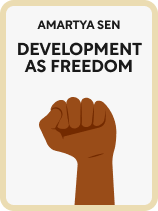

This article is an excerpt from the Shortform book guide to "Development as Freedom" by Amartya Sen. Shortform has the world's best summaries and analyses of books you should be reading.
Like this article? Sign up for a free trial here .
What problems are developing countries facing? What are the causes of these problems?
Hunger, population control, and famine are among the most concerning issues in less developed countries. Amartya Sen in Development as Freedom says that the underlying causes might not be what you think they are.
Let’s look at these particular problems in developing countries and why Sen believes they became problems in the first place.
Hunger, Population Control, and Famine
Sen believes that hunger, population, and famine are the biggest problems in developing countries. Sen explains these problems, what’s wrong with current approaches, and how his approach to development addresses a rapidly growing population and food supply issues. But first, he explains how hunger and famine are becoming a mass issue because of overpopulation through the Malthus model.
The Malthus Model
Sen argues the answer to the pressures of a rapidly growing population lies in expanding freedom, not restricting it. Many poor nations with rapidly growing populations have adopted freedom-restricting policies based on a now-debunked population growth model developed by Thomas Malthus in the 19th century.
According to Malthus, because population grows exponentially while the food supply grows linearly, famines are unavoidable. When the population grows too large for the food supply to sustain, he argued, people will starve. To prevent this, Malthus thought the only remedy was for the government to adopt policies of population control.
The Malthus model has been roundly refuted by modern economists for ignoring technological innovations, which have enabled sizable increases in food production. Despite this, there are still concerns about the impact of a rapidly growing population on food supply, because the logistics of getting food where it’s most needed remains a challenge.
1. Hunger
The first problem in developing countries is hunger. Given the pace of global population growth and the prevalence of hunger in the world, many people have speculated that there simply isn’t enough food to go around. But in Sen’s view, hunger is not a consequence of a limited food supply.
Sen shows that food production per capita has increased substantially since the 1970s in every region of the globe except Africa. What’s more, the largest increases came in China and India—the two regions that have experienced the most rapid population growth over the period.
So despite their growing populations, China and India have managed to increase the food available to their people.
As for Africa, which saw a reduction in food production per capita, Sen argues this problem is part of a much larger issue of political and economic mismanagement and not about food production itself.
The Global Price of Food
In addition to there being more food to go around, Sen notes that food is more affordable as well. Compared to 1950-1952, the prices of four staple crops (wheat, rice, sorghum, and maize) have all decreased by at least 60%.
Despite occasional fluctuations, the general trend has been for food prices to drop, meaning even the poor have more access to food than they did previously.
(Shortform note: Since 2000, global cereal production has increased by around 44%, and the percentage of underweight children in Sub-Saharan Africa has fallen from 25% to 17%. The world has enough food to go around, and it can be imported in places where changes in climate or economic arrangement have made growing food more challenging.)

———End of Preview———
Like what you just read? Read the rest of the world's best book summary and analysis of Amartya Sen's "Development as Freedom" at Shortform .
Here's what you'll find in our full Development as Freedom summary :
- The five types of freedom that are integral to economic development
- How democracy can prevent famine
- How empowering women helps communities






